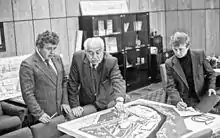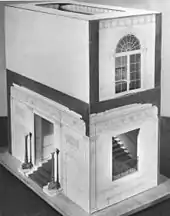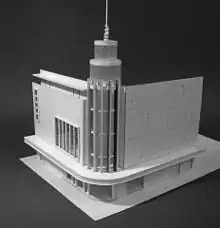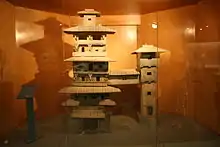Architectural model
An architectural model is a type of scale model – a physical representation of a structure – built to study aspects of an architectural design or to communicate design ideas.

Depending on the purpose, models can be made from a variety of materials, including blocks, paper, and wood, and at a variety of scales.
History
Architectural models have been in use since pre-history. The oldest models were found in Malta, such as at Tarxien Temples, and are now at the archaeology museum in Valletta.[1]
Purpose

Architectural models are used by architects for a range of purposes:
- Ad hoc models, or sketch models, are sometimes made to study the interaction of volumes, different viewpoints, or concepts during the design process. They may also be useful in explaining a complicated or unusual design to builders, or as a focus for discussion between designers and consultants such as architects, engineers and town planners.
- Presentation models can be used to exhibit, visualise or sell a final design. A model are also used as show pieces, for instance as a feature in the reception of a building, or as part of a museum exhibition such as scale replicas of historical buildings.
Types of models include:
- Exterior models are models of buildings which usually include some landscaping or civic spaces around the building.
- Interior models are models showing interior space planning, finishes, colors, furniture and beautification.
- Landscaping design models are models of landscape design and development representing features such as walkways, small bridges, pergolas, vegetation patterns and beautification. Landscaping design models usually represent public spaces and may, in some cases, include buildings as well.
- Urban models are models typically built at a much smaller scale (starting from 1:500 and less, 1:700, 1:1000, 1:1200, 1:2000, 1:20 000), representing several city blocks, even a whole town or village, large resort, campus, industrial facility, military base and so on. Urban models are a vital tool for town/city planning and development. Urban models of large urban areas are displayed at museums such as the Shanghai Urban Planning Exhibition Center, Queens Museum in New York, the Beijing Planning Exhibition Hall, and the Singapore City Gallery.
- Engineering and construction models show isolated building/structure elements and components and their interaction.
 A model by architect Lorenzo Winslow which he used to explore the structure of the Grand Staircase at the White House for his redesign of the East Wing.
A model by architect Lorenzo Winslow which he used to explore the structure of the Grand Staircase at the White House for his redesign of the East Wing. Model of a museum building.
Model of a museum building. Model of a building interior.
Model of a building interior. A scale replica model of the demolished Capitol Theatre in Causeway Bay, Hong Kong
A scale replica model of the demolished Capitol Theatre in Causeway Bay, Hong Kong A model used for urban planning in the Buenos Aires Province
A model used for urban planning in the Buenos Aires Province
Virtual modeling
Buildings are increasingly designed in software with CAD (computer-aided design) systems. Early virtual modelling involved the fixing of arbitrary lines and points in virtual space, mainly to produce technical drawings. Modern packages include advanced features such as databases of components, automated engineering calculations, visual fly-throughs, dynamic reflections, and accurate textures and colours.[2][3]
As an extension to CAD (computer-aided design) and BIM (building information modelling), virtual reality architectural sessions are also being adopted at increasingly faster rates. As this technology enables participants to be immersed in a 1:1 scale model, essentially experiencing the building before it is even being built.
Materials
Rough study models can be made quickly using cardboard, wooden blocks, polystyrene, foam, foam boards and other materials. Such models are an efficient design tool for three-dimensional understanding of a structure, space or form, used by architects, interior designers and exhibit designers.
Common materials used for centuries in architectural model building were card stock, balsa wood, basswood and other woods. Modern professional architectural model builders are taking advantage of twenty-first century materials, such as Taskboard (a flexible and lightweight wood/fiber board), plastics, wooden and wooden-plastic composites, foams, foam board and urethane compounds.
A number of companies produce ready-made pieces for structural components (e.g. girders, beams), siding, furniture, figures (people), vehicles, trees, bushes and other features which are found in the models. Features such as vehicles, people figurines, trees, street lights and other are called "scenery elements" and serve not only to beautify the model, but also to help the observer to obtain a correct feel of scale and proportions represented by the model.
Increasingly, rapid prototyping techniques such as 3D printing and CNC routing are used to automatically construct models straight from CAD plans.[4]
 An earthenware model of two residential towers, made during the Han Dynasty in China.
An earthenware model of two residential towers, made during the Han Dynasty in China.
 A wooden exterior model of the Royal Military College of Canada grounds.
A wooden exterior model of the Royal Military College of Canada grounds.
Cork models
A cork model is an architectural model made predominantly of cork. The art of cork modelling is also called phelloplasty (Greek φελλός phellos, cork).
Cork was already used in the 16th century in Naples to make Christmas cribs. Crib making became extremely popular there in the 18th and early 19th centuries.
The invention of architectural models made of cork was (self-)attributed to Augusto Rosa (1738-1784) but Giovanni Altieri (documented 1766/67-1790) and above all Antonio Chichi (1743-1816, https://it.wikipedia.org/wiki/File:Tempel_des_Portunus_Gotha.JPG) were already active in Rome as manufacturers of cork models.
Chichi's models were copied with great success by Carl May (1747-1822, https://de.wikipedia.org/wiki/Carl_May) and his son Georg Heinrich May (1790–1853).
Other artists can be mentioned like Luigi Carotti (Rome), Carlo Lucangeli (1747-1812, Rome, Naples), Domenico Padiglione and his sons Agostino and Felice (Naples) and Auguste Pelet (1785-1865, Nîmes). In Marseille, several scale models were made representing archaeological digs by Hippolyte Augier (1830-1889) (Marseille History Museum / Musée d’Histoire de Marseille) or Stanislas Clastrier (1857-1925, https://fr.wikipedia.org/wiki/Stanislas_Clastrier).
Dieter Cöllen is a contemporary phelloplastic.
Collections
Many cork models of classical monuments in Italy were made and sold to tourists during their Grand Tour. Cork, especially when carefully painted, was ideal to reproduce the weathered look of wall surfaces.
As a rule, they were produced on a large scale (the Colosseum in Aschaffenburg is three metres long and one metre high) and with great, almost scientific precision.
Cork models were highly esteemed in the princely courts of the 18th century. They were also acquired for their scientific value by schools of architecture in the late 18th/early 19th century, or institutions like the Society of Antiquaries of London and the British Museum thus introducing the general public to ancient architecture.
Despite their fragility, cork models have often survived better than wooden models threatened by wood-destroying insects.
Apart from kings and princes, cork models were collected by people such as Filippo Farsetti (1703-1774) in Venice, Pierre Gaspard Marie Grimod d'Orsay (1748-1809) or the architect Louis-François Cassas in France, Charles Townley or Sir J. Soane in London, who turned his home into a museum, Sir John Soane's Museum, housing a collection of 14 models in cork of Roman and Greek buildings.
Chichi's cork models can be found at the Imperial Academy of Arts in St. Petersburg (34 models made around 1774); Schloss Wilhelmshöhe, Kassel (33 models made 1777-1782); Hessisches Landesmuseum Darmstadt (26 models acquired 1790/91); and the Herzogliches Museum Gotha (12 models, acquired after 1777/78. See Wikipedia in German).
The largest collection of cork models by Carl May with 54 pieces (after war losses) is in Aschaffenburg (Schloss Johannisburg), another large collection of his models is in the Staatliches Museum Schwerin.
In France, the Musée des Antiquités Nationales à Saint-Germain-en-Laye, has works by Rosa,[5] Lucandeli[6] or Pelet.[7] The Musée archéologique de Nîmes (https://fr.wikipedia.org/wiki/Mus%C3%A9e_arch%C3%A9ologique_de_N%C3%AEmes), and the Marseille History Museum also have cork models.
Modern cork models of antique buildings by Dieter Cöllen are exhibited in the Praetorium in Cologne.[8]
Scales
Architectural models are being constructed at much smaller scale than their 1:1 counterpart.
The scales and their architectural use is broadly as follows:
- 1:1 Full (or real) size for details
- 1:2 Details
- 1:5 Details
- 1:10 Interior spaces/furniture
- 1:20 Interior spaces/furniture
- 1:50 Interior spaces/detailed floor plans/different floor levels
- 1:100 Building plans/layouts
- 1:200 Building plans/layouts
- 1:500 Building layouts/site plans
- 1:1000 Urban scale for site or location plans
- 1:1250 Site plans
- 1:2500 Site plans/city maps
- 1:5000 City maps/Island
Sometimes model railroad scales such as 1:160 and 1:87 are used due to ready availability of commercial figures, vehicles and trees in those scales, and models of large buildings are most often built in approximately that range of scales due to size considerations.
See also
- Architectural rendering
- Building model (non-architectural)
- Maquette
- Origamic architecture (OA)
- Scale model
- Superquick
References
- Pace, Anthony (2004). "Tarxien". In Daniel Cilia (ed.). Malta before History – The World's Oldest Free Standing Stone Architecture. Miranda Publishers. ISBN 978-9990985085.
- "What is Architectural Visualisation?". Flying 3D. Retrieved 18 June 2015.
- "What is Accurate Visual Representation?". Flying 3D. Retrieved 18 June 2015.
- Ian Gibson; Thomas Kvan; Ling Wai Ming (2002). "Rapid prototyping for architectural models". Rapid Prototyping Journal. 8 (2): 91–95. doi:10.1108/13552540210420961.
- http://www.ensba.fr/ow2/catzarts/rechcroisee.xsp?f=Ensemble&v=&f=Auteur_field&v=Rosa%2C+Agostino&e=
- http://www.ensba.fr/ow2/catzarts/rechcroisee.xsp?f=Ensemble&v=&f=Auteur_field&v=Lucangeli%2C+Carlo&e==
- http://www.ensba.fr/ow2/catzarts/rechcroisee.xsp?f=Ensemble&v=&f=Auteur_field&v=Pelet%2C+Auguste&e==
- http://www.museenkoeln.de/archaeologische-zone/default.asp
External links
- What is the role of Revit 3D modelling in construction?, Role of Architectural model in construction
| Wikimedia Commons has media related to Architectural models. |
